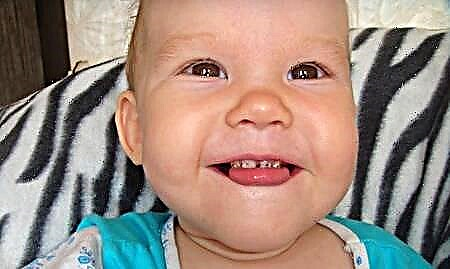Six months of age is the first significant milestone in the life of a little man, which is celebrated by all parents. By this time, the child has adapted well to the surrounding conditions, and loved ones have learned to understand well and even anticipate his needs.

In the daily routine of a six-month-old child, there are some changes associated with an increase in the duration of wakefulness, since a strengthened baby is able to remain active for a longer time.
Approximate day regimen for a child at 6 months: table
- 6:00-8:30 The time of waking up, making the morning toilet, taking air baths and the first feeding of the baby;
- 8:30-10:00 Deep morning sleep;
- 10:00-13:00 The second period of wakefulness, including feeding, performing a set of physical exercises, followed by light massage;
- 13:00-13:30 Third feeding of the baby;
- 13:30-15:00 Daytime nap in the fresh air;
- 15:00-17:00 Developing active leisure, consisting of alternating gymnastic exercises and developing games;
- 17:00-17:30 Time of the fourth meal;
- 17:30-19:00 Informative walk, smoothly turning into sleep;
- 19:00-21:00 The period of wakefulness, filled with developing activities, communication with loved ones; bathing the baby;
- 21:00-21:30 Last feeding;
- 21:30-6.00 Night rest.
A few more additional options with the daily routine (you will already select the best option, taking into account the characteristics of your baby):
This is an approximate diagram of the daily routine designed to meet the physiological needs of a baby at 6 months of age for food, wakefulness and rest. It provides a four-hour gap between feedings, three naps and two walks in the fresh air..
Taking into account these recommendations and looking closely at the behavior of her crumbs, each caring mother can independently make up for him an individual daily regimen, taking into account his preferences and features of natural biorhythms as much as possible.
Hygiene procedures
Hygienic childcare procedures consist of a mandatory morning toilet ritual, washing the child after each bowel movement and evening bathing.
- The complex of morning hygiene procedures, including washing the crumbs, caring for the ears, eyes and mouth, is extremely important both for the child's health and for the formation of a healthy habit. Few mothers know that it is necessary to cleanse the child's oral cavity from pathogenic microorganisms even before the first teeth appear. For this purpose, special napkins are intended, made in the form of a fingertip soaked in a cleansing vegetable solution. To prevent the development of caries, pediatric thrush and stomatitis, you should wipe the mucous membranes and the surface of the tongue with the aforementioned napkin after each meal. The cleansing composition is so safe that wipes soaked in it can be used to sanitize the oral cavity of children in the first days of life. No rinsing or rinsing is required after use;
- When changing a baby's diaper, you must either wash it under a stream of warm running water, or wipe it thoroughly with a hygienic damp cloth (the first option is preferable). After washing, you should not rush to put on a new diaper, giving the baby the opportunity to be naked for some time: air baths help to harden the crumbs and serve as the best prevention of diaper rash;
- The evening bathing ritual for a six-month-old baby is best done an hour before bedtime. The optimal water temperature for this remains the same: 37 degrees, but instead of the usual herbal decoction, you can pour into it a special product intended for bathing a child... Considering that a baby of this age knows how to sit well, holding a rubber toy in the handles, the bathing procedure is quite fun and interesting.
We read a detailed article on child hygiene - https://razvitie-krohi.ru/uhod-za-rebenkom/ezhednevnaya-gigiena-novorozhdennogo.html
Sleep
The total sleep time of a 6-month-old baby is usually about fifteen hours, ten of which are allotted a night's rest, and the duration of each nap period is reduced from two to one and a half hours..
Most babies still need a three-day rest, although there are some very active babies for whom two periods of nap are enough.
If the mother sees that her baby is feeling great and does not show signs of fatigue, despite the fact that it is time for a nap on the schedule, you should not force it to sleep. The child is already able to express his dissatisfaction by arranging a tantrum in response to such actions on the part of adults.
A very good indicator of healthy sleep is the ability of a child to fall asleep easily without any motion sickness and additional stimulation (in the form of a nipple and humming lullabies). It is from this age that it is necessary to teach the baby to sleep only in his crib..
The baby's sleep schedule, how we fall asleep at 6 months:
Feed
Breastfeeding is still the ideal nutritional option for a six month old baby. According to authoritative experts, it should be preserved as long as possible, however, the nutritional value of mother's milk becomes insufficient to feed a grown child. That is why the diet of infants requires the mandatory introduction of complementary foods. (the artificial people had already met him two months earlier).
Juices and monocomponent purees from fruits and vegetables (most often apples, broccoli, cauliflower, pumpkin and zucchini are used) are ideal products for feeding half-yearly children. You should start complementary foods very carefully: with a few drops of apple juice or half a teaspoon of vegetable puree.
The best time for a baby to get acquainted with a new product is the period of the second feeding, since in this case the mother has the opportunity to observe the reaction of his body to the new food... If skin rashes and changes in the nature of the stool do not follow, the amount of complementary foods is gradually increased every day.
In the same way, dairy-free single-grain cereals should be introduced: starting with half a spoon and making sure that the product is well tolerated, its portion is gradually increased to an amount that completely replaces one attachment to the mother's breast. The yolk of a hard-boiled chicken egg is very useful for six-month-old babies. It is introduced into the diet by several grains diluted in milk.
After new products (cereals, juices, yolk and mashed potatoes) become familiar to the baby, his daily diet will be something like this:
- 6:00 Breast milk feeding;
- 10:00 Vegetable puree (200 ml) with a few grains of yolk;
- 13:00 Breastfeeding, fruit puree (30 ml);
- 17:00 Dairy-free one-grain porridge (200 ml), 30 ml of vegetable (carrot, beet) juice;
- 21:00 Feeding with breast milk.
Considering that for one latching on to the breast, the child receives from 200 to 250 ml of mother's milk, his daily ration consists of 850 ml of milk and 400 ml of complementary foods. The diet of artificial babies consists of about the same amount of milk cereals, juices and fruit purees.
We read about how to introduce complementary foods to breastfed babies - https://razvitie-krohi.ru/prikorm/nachalo-prikorma-detey-na-gv.html
The main criterion for the sufficiency of nutrition is the behavior of the baby himself: if he behaves calmly for four hours separating one feeding from another, it means that the food received saturates him well... Also, if the child is gaining weight correctly, then it is getting enough nutrition.
Some semi-annuals retain the habit of waking up in the middle of the night, demanding feeding. Usually babies behave this way; the artificial, having a hearty supper with porridge, sleep in a sound, sound sleep.
My complementary foods table by month (6-9 months):
Developing activities
- For a six-month-old baby, bright sounded toys and objects that emit different sounds are interesting. When giving the baby a new toy, the mother must call her.
- It is very important that toys are made from a wide variety of materials: rubber, plastic, wood, fur and fabric. By touching their surface, the baby enriches his tactile and sensory sensations. If the mother accompanies the baby's play with comments about the properties of each toy (the cube is hard, the tumbler is smooth, the bear is soft), his passive vocabulary will be enriched with many new words, which will subsequently have an important impact on the development of correct speech.
- Do not forget that at this age babies are actively teething, so parents should provide them with teether toys. The process of washing toys that have been in the hands of crumbs should become daily.
- To develop fine motor skills, you can purchase high-quality spiral toys containing objects strung on them: balls, cubes and rings. Toys containing a large number of small parts, holes, pockets, laces and locks will be no less useful. When playing with them, the presence of an adult is mandatory.
- If the parents have not yet purchased a development center for the baby, six months of age is the time for such a purchase. The multitude of light, sound and sensory effects hidden in this toy will give the baby great pleasure and the opportunity to develop hearing, touch and eye.
- The development of fine motor skills of tiny pens is greatly facilitated by the finger games "Ladushki", "Magpie-crow".
http://www.youtube.com/watch?v=XtvYOyNbTiE
Gymnastics, massage and walking with the baby
Six months of age is a time of great physical achievements for a child. Most children begin to sit, actively crawl and roll over from back to tummy, doing it in any direction. In order for the further physical development of the baby to take place as efficiently as possible, it is necessary to strengthen its muscles daily with the help of gymnastics, massage and physical exercises..
We also read about what a child can do at 6 months - https://razvitie-krohi.ru/razvitie-rebenka-do-goda/navyiki-i-umenie-po-mesyatsam/chemu-nauchilsya-rebenok-v-pol- goda.html
- In the complexes of morning gymnastics and physical education, it is imperative to include exercises for stretching the arms and legs, their flexion and extension, exercises based on all four limbs, with the baby on the legs and power load;
- After completing the exercises, the baby should definitely have a relaxing massage: by relieving tension from the muscles, it will delight the baby. Performing it at home, mom can use massage movements known to her, which boil down to gentle rubbing, stroking, pinching, kneading the delicate baby skin and growing muscles. Before proceeding with the massage, the mother needs to consult with the pediatrician who is watching him: he will advise the complex of the most effective techniques;
- No less useful is the massage performed after the evening bathing of the baby. At this moment, it can be combined with performing simple gymnastics, forcing the crumbs to swing with legs and arms, sit him down with his knees brought together, tear his body off the table surface, lifting it by the arms or by the legs.
Realizing the extraordinary benefits of fresh air for strengthening the health of a six-month-old baby, in his daily routine, mom should take time for two walks. Their duration in good weather can be at least 2.5 hours.
If mom is very busy with some business, dad or one of the adult family members can go for a second walk with the baby. If this option is impossible, it is necessary to ventilate the nursery as often as possible and put the baby to sleep with the window open (of course, taking care of the absence of drafts).
How to assess the development of a child at 6 months:
[sc: rsa]
Why is it so important that the child is accustomed to a certain daily routine? Firstly, it contributes to a good mood, health and successful development of the baby himself. Secondly, the predictability of his behavior and the habit of falling asleep at certain hours helps mom to carve out a minute for herself, as well as redo a lot of useful household chores.
← daily routine at 5 months daily regimen at 7 months →
We also read about the development of a child at 6 months - https://razvitie-krohi.ru/razvitie-rebenka-do-goda/mesyats-1-12/razvitie-rebenka-v-6-mesyatsev.html
VIDEO GUIDE: Mommy Mode
***




